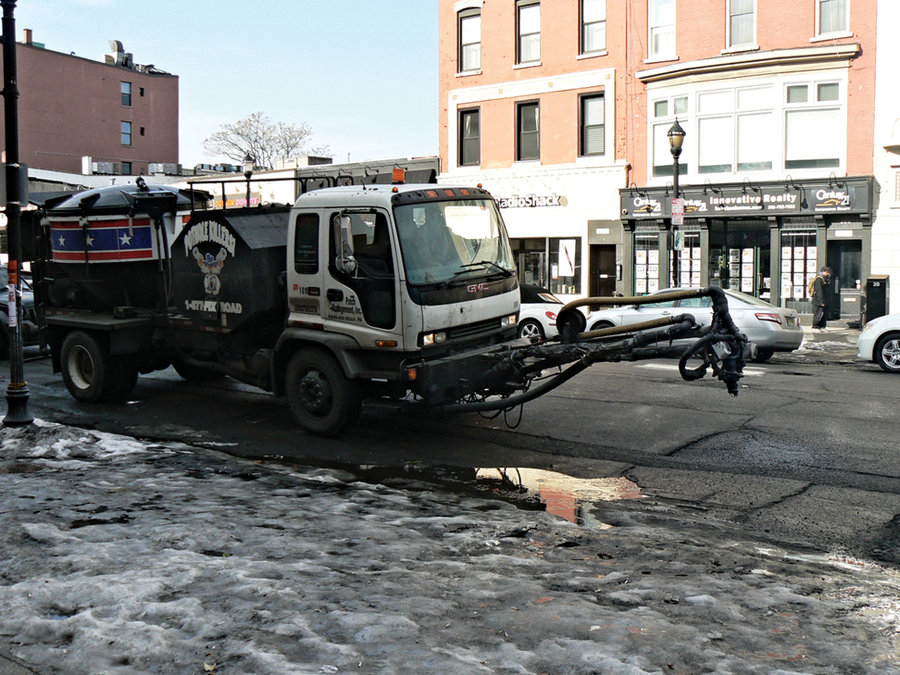Hardened winter has finally given way to spring in Hoboken, and as always, the city’s streets have no choice but to follow suit. Thousands of cracks and hidden cavities in the asphalt, gradually weakened by a vicious cycle of freezes and thaws, are now ticking time bombs, lying in wait for a well-placed tire. They may be harder to spot on Hoboken’s habitually moonscaped thoroughfares, but fresh potholes presage the coming of spring as readily as robins.
According to the American Society of Civil Engineers, New Jersey drivers spend an average of $604 per year on repairs triggered by the state’s dilapidated roads.
The administration of Mayor Dawn Zimmer says it is well aware of the pothole pandemic, but has seen its efforts to resurface the city’s worst streets frustrated by financial and infrastructure constraints. While it hopes to see a marked increase in resurfacing this year, including the full lengths of Bloomfield Street and Observer Highway, the city has also introduced what it calls a better temporary fix for potholes citywide.
Going in for the kill
That fix is the “Pothole Killer,” a specialized spray injection patching machine developed and operated by Pennsylvania-based Patch Management Inc. The truck-mounted system mixes its own proprietary blend of asphalt and gravel and applies it to potholes via a long nozzle–imagine an iron elephant with four wheels and a very animatronic trunk.
Health and Human Service Director Leo Pellegrini said the new service was superior in every way to the city’s former pothole palliatives.
“This new approach eliminates an entire step and is faster, safer, [and] less expensive.”—Leo Pellegrini
____________
Where manual cold patching can take up to a half hour per pothole, the “Pothole Killer” can fill a crater or crack in 90 seconds flat. Instead of requiring a crew of four, the “Pothole Killer” is operated by a single technician, freeing up city workers for other tasks. Best of all, the patches last longer because they use a mixture of hot asphalt and gravel, which binds more readily to the roadbed.
The new system also appears to offer significant cost savings over other methods of pothole filling—the city paid Patch Management Inc. only $17,500 for 80 hours of work in the city. By comparison, said Pellegrini, the city spent $50,000 last year on just the cold patch material it used to fill potholes.
The “Pothole Killer” can even generate a report on the exact geographic coordinates of each pothole it fills. Over the first five days of its contract in Hoboken, the machine filled 923 potholes on Washington Street, Jackson Street, Bloomfield Street, Clinton Street, Fourth Street, and Fifteenth Street, among others, according to a city press release.
Already, Pellegrini said he wants to bring the “Pothole Killer” back for a third week of service.
Residents can assist the city by reporting potholes via www.hoboken311.com or through the Hoboken 311 application for iOS and Android.
The path to repaving
Of course, even the best pothole patch is not designed to last as long as brand new blacktop. In the same press release that detailed the advantages of the “Pothole Killer,” the city of Hoboken promised to repave more than 50 blocks of roadway this year and released a map showing which streets will be covered by the program.
Eagle-eyed readers may observe that the streets marked for repaving in 2015 are the same streets highlighted as part of the “2014 Road Resurfacing Program” on maps released by the city last July.
City spokesman Juan Melli said last year’s repaving plans were pinched by dwindling grants from the state Transportation Trust Fund, which is at least $14.8 billion in debt, according to NorthJersey.com. Where Hoboken once received $1 million annually from the state for repaving, it got around $400,000 last year, only enough to cover a handful of blocks.
In addition, a push by Public Service Electric and Gas Company to replace 60 percent of the cast iron gas lines in Hoboken, which required digging 18-inch wide trenches in the roadbed, delayed full resurfacing on streets like Fourth Street and Bloomfield Street.
However, there is some cause to believe the city’s 2015 road resurfacing program will be more successful than its 2014 version. For one thing, contracts are already in place for the first two phases of resurfacing, both with Fort Lee-based vendor Reggio Construction.
The first contract, awarded last October, is worth $882,342 and will cover sections of Jackson, Monroe, Fourth, Fifth and Sixth streets in southwest Hoboken. Melli said Reggio was able to complete some of the necessary concrete prep work on this phase before the winter weather arrived.
The second contract, awarded two weeks ago, is worth $1,295,677 and will cover northern sections of Madison, Eighth, Ninth, and Eleventh streets and all but one block of Bloomfield Street.
While state grants for transportation infrastructure remain low, the Hoboken City Council approved $3.8 million in bonds last year to fund road resurfacing on its own. In addition, resurfacing is one of the projects Mayor Zimmer says will be funded with the revenue generated by new meters on the visitor parking side of Hoboken streets.
In addition, Hudson County plans to repave Observer Highway between Jefferson and Hudson streets this year as part of a complete street redesign implemented in coordination with the city. Melli said the project was expected to begin this spring, but could not give a more specific date.
